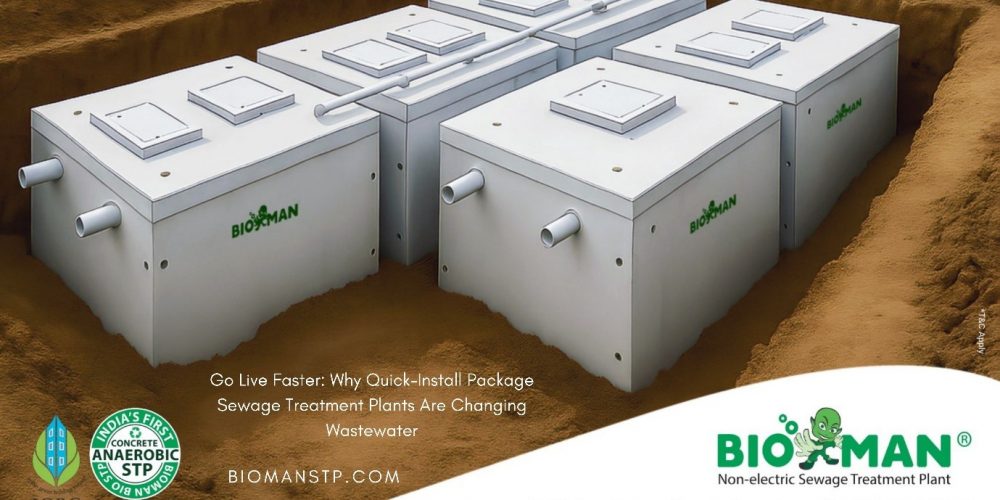The world is moving quicker, and in the realm of facilities, speed and efficiency are no longer high-end—they are requirements. This is specifically true for wastewater management. For years, the typical procedure of constructing a sewage treatment plant (STP) engaged months, or even years, of complex civil building, website interruptions, and unpredictable prices.
Today, a revolutionary option is taking the lead: the Quick-Install Plan Sewage Treatment Plant (PSTP). These modular, premade systems are fundamentally changing the timeline and economics of wastewater management, permitting jobs to “go live” faster than in the past.
The Bottleneck of Traditional STPs
To understand the impact of Bundle STPs, we must initially look at the standard design. A traditional STP is a civil marvel, but it’s a significant endeavour. It includes:
- Substantial Civil Job: Digging huge, deep pits; pouring concrete; and creating different tanks on-site. This work is extremely at risk due to weather delays, labour scarcities, and product cost fluctuations.
- Long Building Timelines: The entire process– from structure to commissioning– can easily cover 6 to 18 months, causing substantial project delays and inflating prices.
- Huge Land Footprint: Conventional systems need significant land area for aeration containers, clarifiers, and sludge drying beds, a significant restraint in cities and overloaded locations.
This drawn-out process suggests that property complications, business advancements, and commercial units wait longer to accomplish conformity, open for organization, and begin recycling cured water.
The Bundle STP Revolution: Prefabrication and Plug-and-Play
A package sewage treatment plant, on the other hand, is a factory-built, modular, and self-supporting device. It integrates the entire therapy process from screening to disinfection into one or a couple of compact storage tanks. This shift from on-site building and construction to off-site production is the core of its game-changing speed.
1. Lightning-Fast Setup and Commissioning
The primary advantage is rate. Since the whole system is built in a regulated factory environment:
- Very Little Site Job: Only a basic structure or base piece is called for on the project website. The plant arrives fully set up.
- Plug-and-Play Configuration: Installation is commonly lowered to a matter of days or a couple of weeks, in contrast to months. The system is simply reduced into place, connected to the inlet/outlet pipelines and the power supply, and it awaits appointing.
- Accelerated Compliance: This fast implementation means businesses and residential communities can satisfy environmental regulatory needs (such as CPCB norms) and safe and secure tenancy certificates much faster.
2. Compact Footprint, Flexible Positioning
In dense city atmospheres, space is one of the most useful products. Package STPs are crafted to be portable and effective, utilizing innovative modern technologies like MBBR (Moving Bed Biofilm Reactor) or SBR (Sequencing Batch Reactor) to attain superior results in a much smaller location.
This smaller footprint allows them to be placed in constricted locations that would certainly be difficult for a standard Bio STP such as:
- Basements of business structures.
- Rooftops of hotels.
- Tiny, energy edges of residential societies.
3. Predictable Cost and High Quality
Manufacturing facility production eliminates the common variables that plague civil building and construction:
- Price Control: Off-site fabrication reduces on-site labor and material waste, providing a very foreseeable and often lower total capital investment (CapEx) for small-to-medium-scale projects.
- Assured Top Quality: Building the system inside, away from negative weather conditions, guarantees far better-quality control, standard welding, and greater structural honesty. The system is checked and licensed prior to it even getting to the site.
More Than Simply Rate: Long-Term Perks
The advantages of a quick installation extend much past the building and construction stage:
- Easy Scalability and Moving: STP Sewage Treatment Plant are modular. As a neighbour hood or industry expands, extra modules can be included flawlessly. Moreover, containerized systems can be moved a huge advantage for temporary sites or remote camps.
- Reduced Operational Expenses (OpEx): Modern PSTPs are designed for power effectiveness and frequently integrate automation and remote surveillance, decreasing the need for continual proficient manpower and decreasing power usage.
The Future is Decentralized and Quick
The pattern is clear: the future of wastewater administration is decentralized. Instead of a solitary, massive, lengthy plant offering an entire area, smaller, quicker-to-install Plan STPs are treating water straight at the source be it an apartment building, a resort, or a manufacturing facility.
For designers and centre managers, the Plan STP is not simply a piece of equipment; it’s an accelerator. It eliminates the biggest infrastructure difficulty, making certain projects are certified, lasting, and lucrative in document time. When you select a quick-install Plan Sewage Treatment Plant, you’re not just buying a remedy– you’re purchasing time to market and long-lasting satisfaction.
